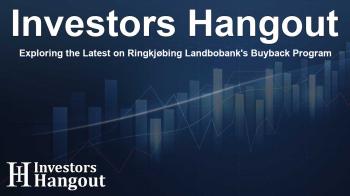Exploring the Latest on Ringkjøbing Landbobank's Buyback Program

Understanding the Share Buyback Programme
Ringkjøbing Landbobank has implemented a robust share buyback programme, which is part of its strategic financial management aimed at enhancing shareholder value. This programme is designed to repurchase shares, thereby reducing the number of shares in circulation and potentially increasing earnings per share for existing shareholders.
Programme Overview
The current share buyback programme is set to run from June to January of the following year. During this time, the bank aims to repurchase shares worth up to DKK 1,000 million, while capping the total number of shares repurchased at 1,600,000. Such a strategic financial maneuver not only reflects confidence in the bank's operations but also an initiative to optimize capital structure.
Regulatory Compliance
This initiative complies with established regulations to ensure transparency and investor protection. Specifically, it adheres to EU Commission Regulation No. 596/2014 and the subsequent delegated regulation, which together create a framework for share buybacks under the 'Safe Harbour' provisions.
Recent Transactions Under the Buyback Scheme
As of the latest reports, the bank has successfully repurchased over 144,500 shares under the buyback programme. The average purchase price of these shares has been calculated at DKK 1,364.94.
Detailed Transaction Insights
Highlights of the recent buyback transactions include:
- On July 7, the bank repurchased 4,000 shares at an average price of DKK 1,396.27.
- Subsequent transactions on July 8 and July 9 involved additional purchases at slightly varying prices, showcasing an active response to market conditions.
Impact on Shareholder Equity
With the shares currently held by the bank, approximately 2.20% of the total share capital is under its ownership. This strategic move not only aims to stabilize the share price but also expresses the bank's commitment to returning value to its shareholders through focused capital management practices.
Frequently Asked Questions
1. What is a share buyback programme?
A share buyback programme allows a company to purchase its own shares from the marketplace, thereby reducing the number of outstanding shares and potentially increasing the share price.
2. How does this programme affect shareholders?
By reducing the number of shares in circulation, a buyback programme can increase the earnings per share (EPS) and return value to existing shareholders.
3. What regulations govern this programme?
The programme is governed by EU Commission Regulation and Delegated Regulation, ensuring regulatory compliance and protecting investor interests.
4. How many shares has Ringkjøbing Landbobank bought back?
As of the latest updates, the bank has repurchased over 144,500 shares under its buyback programme.
5. What is the purpose of share buybacks?
The main purpose of share buybacks is to enhance shareholder value, stabilize the share price, and optimize the company’s capital structure. Additionally, they signal confidence in the company’s financial health.
About The Author
Contact Logan Wright privately here. Or send an email with ATTN: Logan Wright as the subject to contact@investorshangout.com.
About Investors Hangout
Investors Hangout is a leading online stock forum for financial discussion and learning, offering a wide range of free tools and resources. It draws in traders of all levels, who exchange market knowledge, investigate trading tactics, and keep an eye on industry developments in real time. Featuring financial articles, stock message boards, quotes, charts, company profiles, and live news updates. Through cooperative learning and a wealth of informational resources, it helps users from novices creating their first portfolios to experts honing their techniques. Join Investors Hangout today: https://investorshangout.com/
The content of this article is based on factual, publicly available information and does not represent legal, financial, or investment advice. Investors Hangout does not offer financial advice, and the author is not a licensed financial advisor. Consult a qualified advisor before making any financial or investment decisions based on this article. This article should not be considered advice to purchase, sell, or hold any securities or other investments. If any of the material provided here is inaccurate, please contact us for corrections.

